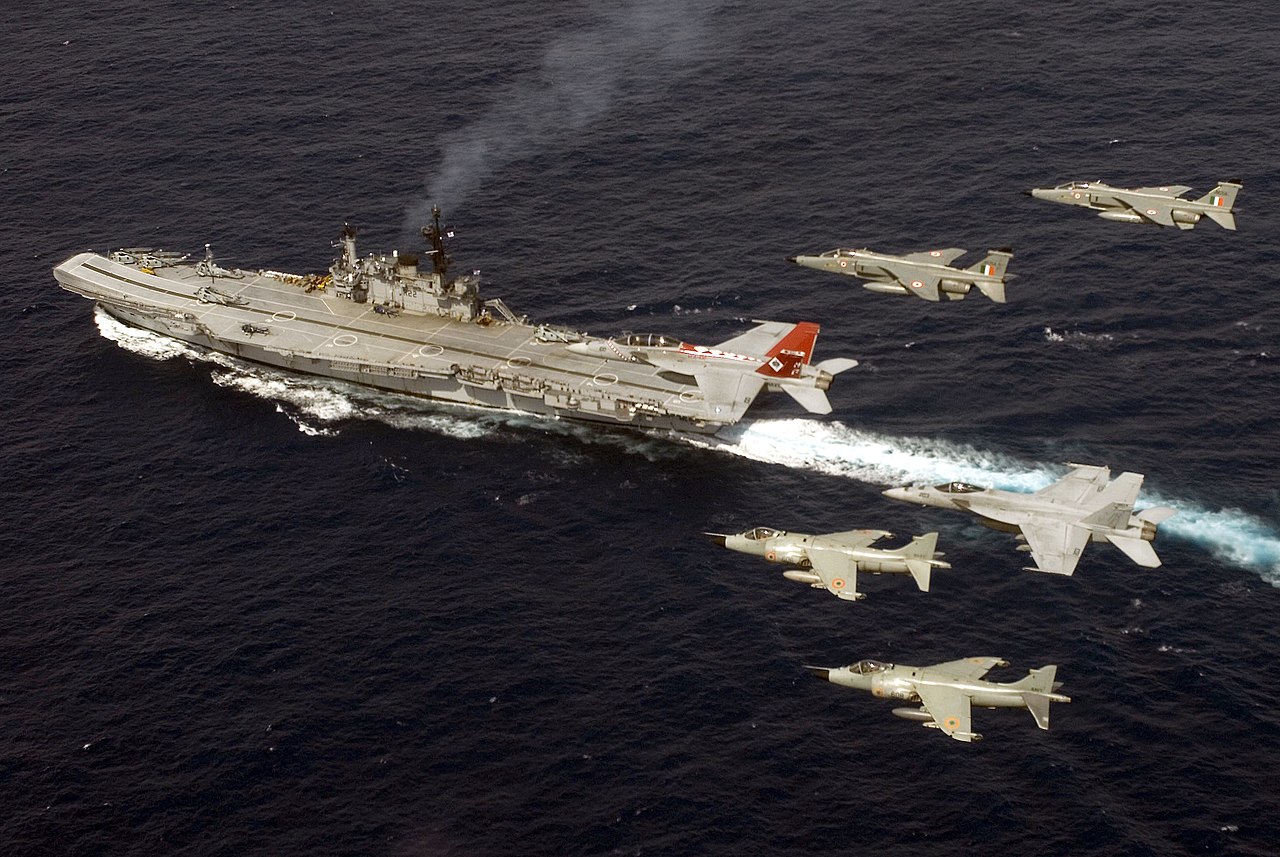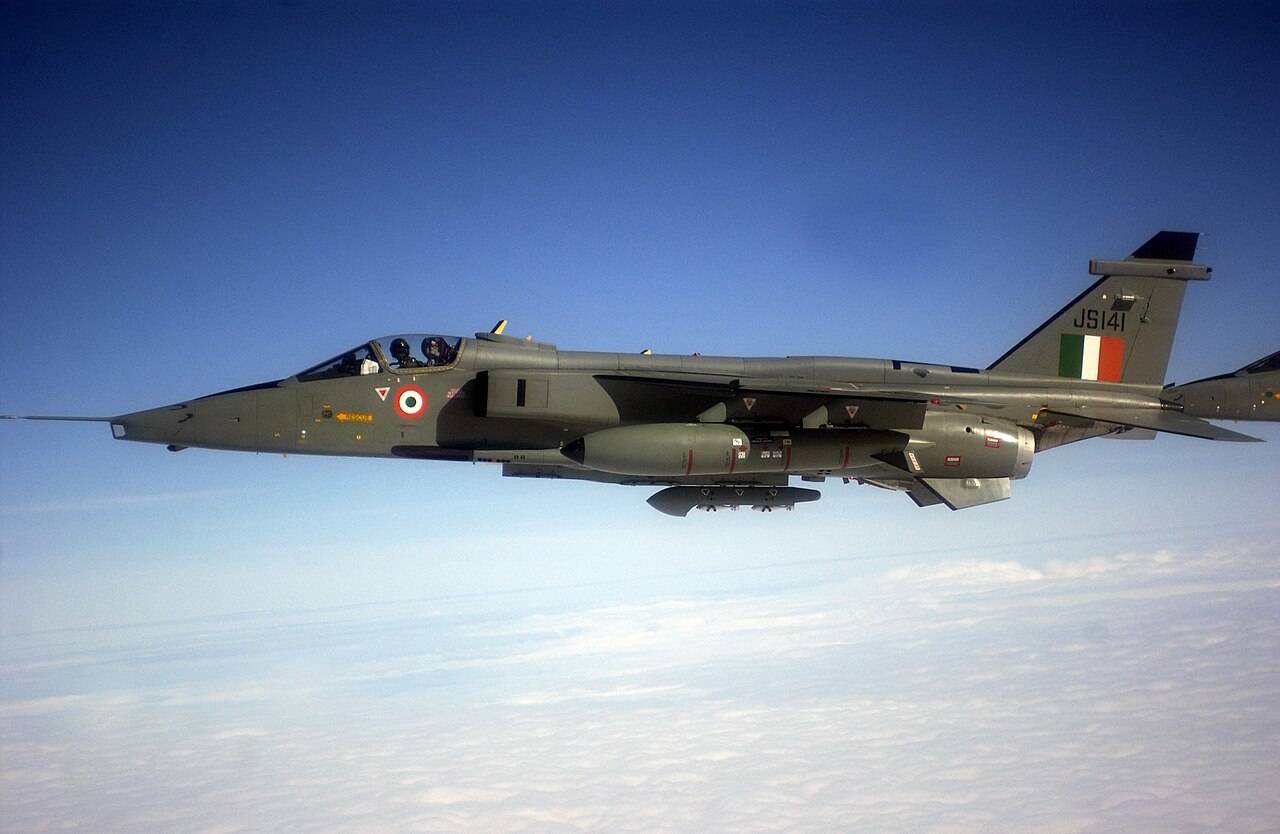With Modified Headlines
The Indian Air Force (IAF) reportedly plans to begin phasing out its Jaguar strike aircraft starting in 2027-2028, with the complete phase-out scheduled by 2035-2040.
Considering the relentless depletion of the IAF’s fighter inventory—due to delays in planned acquisitions and repeated timeline slippages in the Tejas Mk-1A program—the Jaguar phaseout could adversely affect the IAF’s operational capability.
The Jaguar is a capable aircraft that packs a punch. It’s unique in its ability to fly at low heights over a long range. At 200 ft outside AWACS coverage, a Jaguar can get more stealthy than an F-22 Raptor at higher altitudes.
Continuing Relevance
Jaguar has continued in service despite the IAF’s doctrinal shift to high-altitude warfare, which relies on long-range precision-guided munition.
One reason why the Jaguar has remained relevant is that the IAF has adopted the fighter for medium-altitude stand-off strikes. We will look at the Jaguar’s medium altitude strike capability later in this narrative.
The ongoing conflict in Ukraine has emphasized the continued relevance of a fighter such as the Jaguar. The conflict has illustrated that low-level penetration of contested airspace by attack aircraft is far safer than medium-altitude penetration because of the widespread use of and increased capabilities of AD (Air Defence) systems.
Ukrainian MiG-29s, Su-24, Su-25, and Su-27 fighters invariably fly to their standoff weapon launch points at very low altitudes, below the adversary’s radar horizon, to escape detection. Nearing the launch point, they zoom up, launch their weapons, and once again “hit the deck.”
Russian Su-34 and Su-25 follow similar attack profiles. The Jaguar is optimized for such attack profiles.
DARIN Upgrades
Since its initial induction into the IAF in the early 1980s, the IAF, in partnership with HAL and DRDO, has continuously upgraded the Jaguar to improve its stand-off attack, strike range, and target acquisition capabilities.
The upgrades, referred to as DARIN (Display Attack Ranging Inertial Navigation) upgrades, were done in three phases – DARIN-1, DARIN-2 and DARIN-3.
The upgrades involved integrating new mission computers and software, cockpit displays (SMDs, Engine, and Flight Instrumentation Systems), a Fire Control Radar, a Hybrid navigation system, and an Autopilot with advanced modes.
DARIN 3 Jaguars feature a fully functional glass cockpit and an AESA radar as the primary sensor. Their ability to detect air, surface, and sea targets has been enhanced manifolds.
The DARIN I upgrade introduced advanced navigation and attack systems, including a new inertial navigation system, HUD/WAC (Head-Up Display/Weapon Aiming Computer), and other avionics improvements.

The DARIN II upgrade gave the Jaguar an Indigenous Electronic Warfare Suite, which comprises advanced radar warning receivers like the Tarang Mk II, along with other countermeasures. DARIN II also involved improvements in the navigation and attack systems, making the Jaguars capable of operating in more challenging electronic warfare environments.
The DARIN III integrated the Israeli EL/M-2052 AESA (Active Electronically Scanned Array) radar, enhancing the aircraft’s air-to-air and air-to-ground capabilities with features like multi-target tracking and frequency agility. The upgrade also featured a glass cockpit, an advanced mission computer, and a new Helmet-Mounted Display System (HMDS) for better situational awareness and target acquisition.
The DARIN III upgrade has been pivotal in preserving the Jaguar’s relevance in modern aerial warfare. In addition to enhancing the aircraft’s combat capabilities, the upgrade facilitates better integration into the IAF’s network-centric warfare framework, resulting in more effective coordination with AWACS and ground-based air defense systems.
Exclusive: How Indian MiG-21s Thrashed F-15 Eagles During Military Drills, Shocking USAF Pilots
DARIN-3 Engine Upgrade
The DARIN-3 upgrade program was to include replacing the Jaguar Adour 811 engine (25 kN dry thrust, 37.5 kN with afterburners) with Honeywell F-125IN engines (27.7 kN dry thrust, 43.8 kN with afterburners). However, the price tag for acquiring the US engines and having HAL swap them onto the Jaguars was assessed as prohibitive.
Limited DARIN-3 Inventory
Based on a news report that Israel’s ELTA has been contracted to upgrade 58 Jaguars with AESA radars, it’s clear that the DARIN-3 upgrade would be limited to 58 Jaguars. Most likely, these are airframes with operational life that extends to 2035 and beyond.
Improved Range
When the Jaguar was initially acquired, it had the plumbing for air-to-air refueling, but the capability was inhibited, most likely because the IAF didn’t see the need for it and, in any case, had no aerial tankers in its inventory.
Inflight refueling on the Jaguar has since been restored as part of the upgrade process. The fighter variant features a retractable refueling probe, while the trainer has a non-retractable probe.
New Weapons
DARIN-3 avionics support the integration of advanced air-to-air missiles like ASRAAM and smart air-to-surface munitions such as the RAMPAGE, Maverick, and Harpoon missiles; Paveway precision-guided munition; Joint Standoff Weapon; and the DRDO-developed SAAW (Smart Anti-Airfield Weapon).

The punch acquired by the Jaguar is now formidable.
The Elbit Systems-developed Rampage is a stand-off weapon with all‐weather capabilities designed for deep penetration strikes. Powered by a solid propellant rocket motor, it has a range of 150–250 km, a flight altitude of 3,000–40,000 ft, and a top speed of Mach 1.6. The claimed CEP is 10 m.
SAAW is an analog of the Israeli Spice glide bomb. When released from 12.8 km height and flying at 0.9 M, it has a range of over 90 km. Its CEP is 7m when using a combination of inertial navigation and GPS + GAGAN. With an IIR seeker for terminal homing, the CEP reduces to 3m!
Other new weapons integrated include Textron CBU-105 “sensor fuzed” Smart Anti-tank Cluster Bomb and DRDO’s 500-kg General Purpose Bomb.
Amid LCA MK-2, MMRCA & AMCA Delays, Indian Air Force To Augment, Upgrade Its MiG-29 Fighter Fleet
Can The Jaguar Continue In Service Longer?
Clearly, the Jaguar is now a potent platform despite being somewhat underpowered. It could be retained in service longer than currently projected to prevent the unacceptable depletion of IAF fighter aircraft inventory. Indeed, that may well be the case!
However, longer service retention could only be achieved by reducing the aircraft’s monthly flying hours.
HAL locally manufactured 145 Jaguar fighters for the IAF. Based on a fatigue analysis, the IAF estimates that the initial lot of Jaguars could remain operational till 2030. Subsequently, manufactured fighters could remain operational from 2035 to 2040.
Service Life Extension
Extending the Jaguar’s technical life is an option. The F-16 has undergone multiple Service Life Extension Programs (SLEP). The F-16 airframe’s original design life was about 8,000 flight hours. After fatigue testing and structural reinforcements, some variants (like the F-16C/D) have been cleared to fly up to 12,000 hours or more. This includes upgrades to the wing structure, fuselage, and bulkheads.
However, extending a fighter’s airframe life is not a trivial task. It would pose a formidable challenge for an airframer like the HAL.
HAL likely lacks the technical equipment for rigorous testing of airframe fatigue or the ability to manufacture airframe components that may need to be replaced/upgraded consequent to the testing. (HAL’s local manufacture of Jaguar fighters was largely an assembly job.)
Engine Life Extension Upgrade
An equally important challenge in extending the Jaguar’s airframe life would be the fact that the Adour Mk.811 engines that power the Jaguar are no longer in production. Also, the performance of existing engines has degraded due to loss of thrust.
However, HAL probably has more options with the Jaguar engine than the airframe.
It’s reported that the Honeywell F-125IN engine option is now off the table.
However, HAL still has the option to replace the Adour 811 with an alternative engine from the Adour 811 family.
Rolls-Royce earlier offered its Adour Mk-821, which has a 90% commonality with the Adour Mk-951 turbofan fitted on BAE Systems/HAL Hawk Mk132, as an alternative with a 20% increase in thrust.
Later, for some reason, the BAE withdrew the offer. It’s unlikely that BAE cannot be persuaded to change its stance. It may even be possible for HAL to power the Jaguar with a reheat variant of its underdevelopment HTFE-25 25-kN Thrust Class Engine.
Indigenous Technology Showcase
In many ways, the DARIN-3 Jaguar is an Indigenous capability showcase. DRDO and HAL have used the Jaguar platform to develop, test, and operationalize avionic capabilities critical to modern fighters.
The DARIN-3 upgrade also illustrates how the focus in modern aerial warfare has shifted from airframe capabilities to avionics and weapon systems capabilities. Airframe capabilities have maxed out, and avionics and weapon systems capabilities will likely never max out.
Continuously modernized, the Jaguar could remain relevant well beyond 2035. Extending airframe life and fitting a replacement engine could come within the capabilities of HAL with overseas vendor support. The economics of extending the service life of the aircraft would, of course, have to be weighed against the operational advantages.
- Vijainder K Thakur is a retired IAF Jaguar pilot, author, software architect, entrepreneur, and military analyst.
- VIEWS PERSONAL OF THE AUTHOR
- Follow the author @vkthakur




